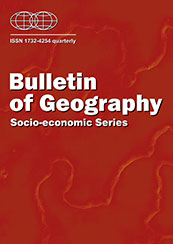The place of community values within community-based conservation: The case of Driftsands Nature Reserve, Cape Town
DOI:
https://doi.org/10.2478/bog-2018-0017Abstract
Contemporary approaches to biodiversity conservation within South Africa depart from community-based initiatives which seek to combine biodiversity conservation with socio-economic development. This paper employs a grounded theory approach to discuss the values of local communities and the management body (CapeNature), with regards to Driftsands Nature Reserve, Cape Town, by way of exploring the ways in which community-based conservation is being achieved within this case study. The findings conclude that the support and environmental education provided by CapeNature is going some way to addressing the needs of community-based conservation. Although the geographical location and demographics of the area produce a number of challenges for this approach, this research outlines the pathways for these challenges to be turned into benefits through even greater involvement with community-based conservation.References
Berkes, F., 2007: Community-based conservation in a globalized world. In: Proceedings of the National Academy of Sciences of the United States of America, Vol. 104(39), pp. 15188–15193. DOI: 10.1073/pnas.0702098104
Biodiversity Information System for Europe, sine anno: Ecosystem services. Available at: https://biodiversity.europa.eu/topics/ecosystem-services, DoA: 10.01.2018.
Brockington, D., Duffy, R. and Igoe, J., 2008: Nature Unbound: conservation, capitalism and the future of protected areas. London, UK: Earthscan.
Brown, K., 2003: Three challenges for a real people-centred conservation. In: Global Ecology and Biogeography, Vol. 12(2), pp. 89–92. DOI: 10.1046/j.1466-822X.2003.00327.x
CapeNature, 2018: Conservation. Available at:
http://www.capenature.co.za/faqs/?topics=conservation, DoA:14.01.2018.
Cast, A., Hatton-MacDonald, D., Grandgirard, A., Kalivos, T., Strathearn, S., Sanderson, M., Bryan, B. and Frahm, D., 2008: South Australian Murray-Darling Basin environmental values report (Water for a Healthy Country National Research Flagship Report series). Glen Osmond, Australia: Commonwealth Scientific and Industrial Research Organisation. Available at:
http://www.clw.csiro.au/publications/waterforahealthycountry/2008/wfhc-MDB-Environmental-Values.pd, DOA: 05.01.2018.
City of Cape Town, 2010: City of Cape Town nature reserves: A network of amazing biodiversity. Available at:
https://www.capetown.gov.za/en/EnvironmentalResourceManagement/publications/Documents/CCT_Nature_Reserves_book_2010-02.pdf, DoA:14.03.2012.
City of Cape Town, 2011: Census 2011 ward profiles. Available at:
http://www.capetown.gov.za/en/stats/Documents/2011_Census_CT_Ward_Index_2.htm">http://www.capetown.gov.za/en/stats/Documents/2011_Census_CT_Ward_Index_2.htm, DoA: 06.04.2013.
Department of Environmental Affairs, sine anno: Welcome to the People and Parks Programme. Available at: http://www.peopleandparks.com, DoA: 21.09.2010.
Department of Environmental Affairs, 2018: Overview of the department. Available at: https://www.environment.gov.za/aboutus/department, DoA: 09.01.2018.
Department of Environmental Affairs and Tourism, 2006: People and Parks Conference “Conservation for the People with the People” (conference report). South Africa: Department of Environmental Affairs and Tourism.
Dymitrow, M. and Halfacree, K., 2018: Sustainability—differently. In: Bulletin of Geography. Socio-economic Series, Vol. 40. DOI: 10.2478/bog-2018-0011
Flint, C.G., Luloff, A.E. and Finley, J.C., 2008: Where is ‘community’ in community-based forestry? In: Society and Natural Resources, Vol. 21(6), pp. 526–537. DOI: 10.1080/08941920701746954
Glaser, B.G. and Strauss, A.L., 1967: The discovery of grounded theory: Strategies for qualitative research. London, UK: Routledge.
Geoview, 2017: Driftsands Nature Reserve. Available at: http://za.geoview.info/driftsands_nature_reserve,187742060w, DoA: 20.01.2018.
Hulme, D. and Murphree, M., 1999: Communities, wildlife and the ‘new conservation’ in Africa. In: Journal of International Development, Vol. 11(2), pp. 277–285. DOI: 10.1002/(SICI)1099-1328(199903/04)11:2<277::AID-JID582>3.0.CO;2-T
Irwin, A., 2001: Sociology and the environment: A critical introduction to society, nature and knowledge. Cambridge, UK: Polity Press.
Isyaku, U., Chindo, M. and Ibrahim, M., 2011: Assessing community-based natural resource management at Lake Naivasha, Kenya. In: Environmental and Natural Resources Research, Vol. 1(1), pp. 106–116. DOI: https://doi.org/10.5539/enrr.v1n1p106
Khadka, C. and Vacik, H., 2012: Comparing a top-down and bottom-up approach to the identification of criteria and indicators for sustainable community forest management in Nepal. In: Forestry: An International Journal of Forest Research, Vol. 85(1), pp. 145–158. DOI:
Lynam, T., de Jong, W., Shell, D., Kusumanto, T. and Evans, K., 2007: A review of tools for incorporating community knowledge, preferences and values into decision making in natural resources management. In: Ecology and Society, Vol. 12(1), paper 5 (no pagination). DOI:
Marshall, C. and Rossman, G.B., 2011: Designing qualitative research. London: Sage.
Muchapondwa, E. and Stage, J., 2015: Whereto with institutions and governance challenges in African wildlife conservation? In: Environmental Research Letters, Vol. 10(9), pp. 1–8 DOI: 10.1088/1748-9326/10/9/095013
Open Africa, 2011: Driftsands Nature Reserve. Available at: http://www.openafrica.org/participant/driftsands-nature-reserve, DoA: 15.01.2018.
Park, C., 2007: A dictionary of environment and conservation. Available at:
http://0-www.oxfordrefernce.com.oasis.unisa.ac.za/views/ENTRY.html?subview=Main&entry=t244.e677, DoA: 10.11.2010.
Rangarajan, M., 2003: Parks, politics and history: Conservation dilemmas in Africa. In: Conservation and Society, Vol. 1(1), pp. 77–98. Available at:
http://www.conservationandsociety.org/article.asp?issn=0972-4923;year=2003;volume=1;issue=1;spage=77;epage=98;aulast=Rangarajan, DoA: 29.01.2018.
Rasmussen, A., Akinsulure-Smith, A.M. and Chu, T., 2016: Grounded theory. In: Jason, L.A. and Glenwich., D.S. editors, Handbook of methodological approaches to community-based research. Oxford: Oxford University Press.
Raymond, C.M., Bryan, B.A., Hatton MacDonald, D., Cast, A., Strathearn, S., Grandgirard, A. and Kalivas, T., 2009: Mapping Community values for natural capital and ecosystem services. In: Ecological Economics, Vol. 68(5), pp. 1301–1315. DOI:
10.1016/j.ecolecon.2008.12.006
Reed, M.S., 2008: Stakeholder participation for environmental management: A literature review. In: Biological Conservation, Vol. 141(10), pp. 2417–2431. DOI:
Roux, D.J., Nel, J.L., Fisher, R.M. and Barendse, J., 2016 Top-down conservation targets and bottom-up management action: Creating complementary feedbacks for freshwater conservation. In: Aquatic Conservation: Marine and Freshwater Ecosystems, Vol. 26(2), pp. 364–380. DOI: 10.1002/aqc.2577
Sarantakos, S., 2005: Social research. Hampshire, UK: Palgrave Macmillan.
Smith, J.L., 2008: A critical appreciation of the “bottom-up” approaches to sustainable water management: Embracing complexity rather the desirability. In: Local Environment, Vol. 13(4), pp. 353–366. DOI: 10.1080/13549830701803323
Tsuji, S., 2015: Did localisation of community-based conservation succeed? A case study on community-based sea turtle conservation in Ma’Daerah sea turtle sanctuary. In: JATI – Journal of Southeast Asian Studies, Vol. 20, pp. 94–106. DOI: 10.22452/jati.vol20no1.6
Downloads
Published
How to Cite
Issue
Section
License
Copyright (c) 2018 Bulletin of Geography. Socio-economic Series

This work is licensed under a Creative Commons Attribution-NoDerivatives 4.0 International License.
Title, logo and layout of journal Bulletin of Geography. Socio-economic Series are reserved trademarks of Bulletin of Geography. Socio-economic Series.Stats
Number of views and downloads: 413
Number of citations: 1



